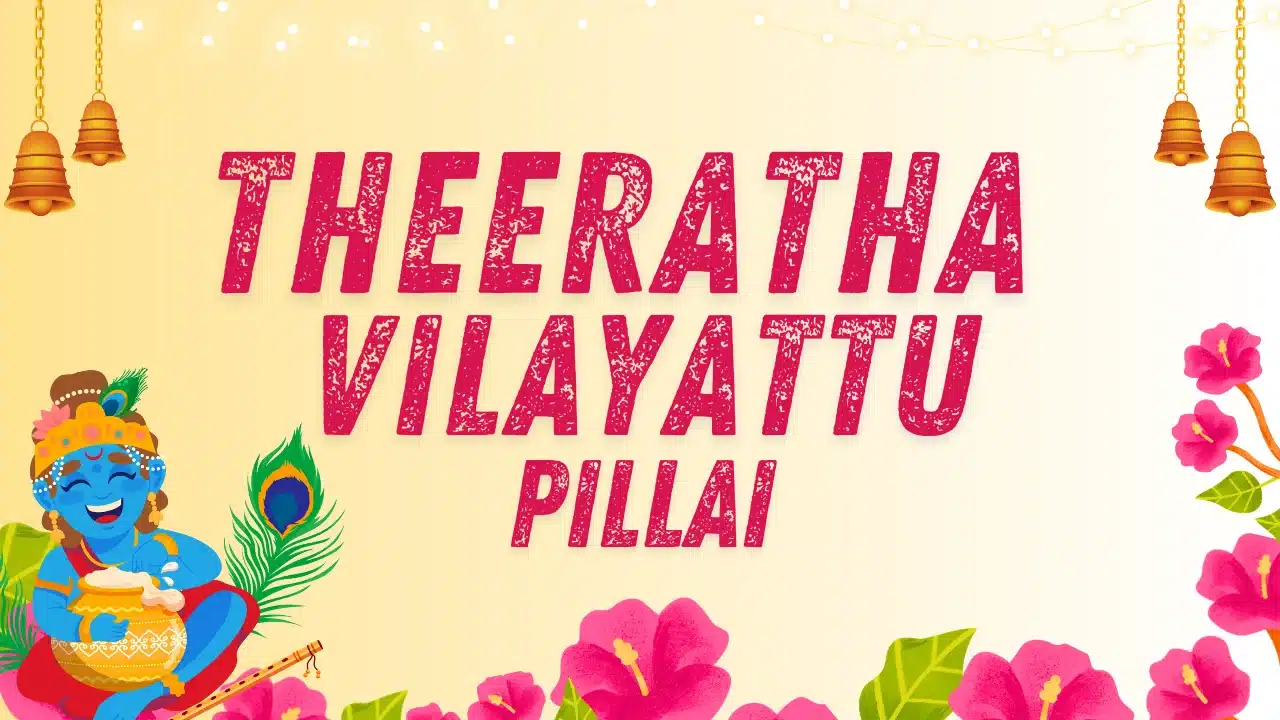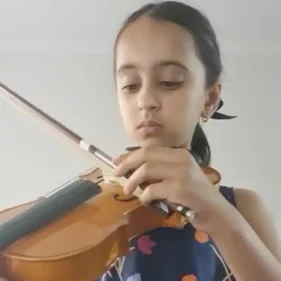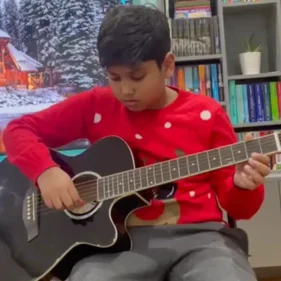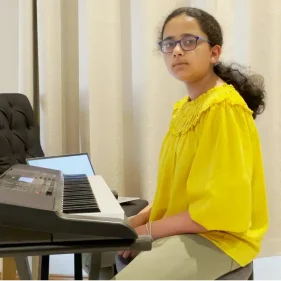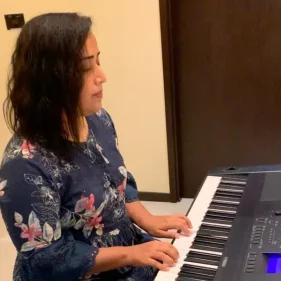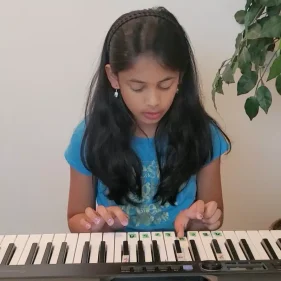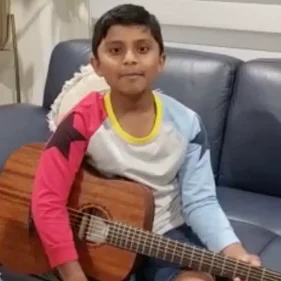- Mahakavi Bharathiyar- The lyricist of Theeratha Vilayattu Pillai
- The Ragas of Theeradha Vilayattu Pillai
- Carnatic Notations of Theeradha Vilayattu Pillai
- Pallavi and Anupallavi – Raga, Notes, Lyrics & Meaning
- Pallavi
- Anupallavi
- Meaning
- Theeratha Vilayattu Pillai Charanam 1
- Theeratha Vilayattu Pillai Charanam 2
- Theeratha Vilayattu Pillai Charanam 3
- FAQs
It’s Janmashtami (Lord Krishna’s Birthday) season. One of the best songs that can elucidate the praise of the mysterious, mischievous god is, Theeratha Vilayattu Pillai lyrics penned by C. Subramania Bharati, which translates to Lord Krisna’s endless playful pranks he plays with the ladies! He loves women dearly and since Krishna is the Parama Purusha, the epitome of masculinity, everything else that is created is feminine. Thus, He takes immense pleasure in performing his tricks with the women folk who always end up taking the brunt.
In Carnatic concerts, this Theeratha Vilayattu Pillai song is rendered as a Ragamalikka comprising 7 short verses or charanams shading the myriad colours of Krishna Leela in a melodious garland of stories, forming the origin of the song. Let’s take a walk through of this ‘light’ song written in simple Tamil, that resonates to every age from 6 to 60!
Mahakavi Bharathiyar- The lyricist of Theeratha Vilayattu Pillai
Everybody who is Tamil knows that Mahakavi Bharatiar, the composer of Theeratha Vilayattu Pillai song and I literally don’t have words to describe this Mahakavi. Born in 1882, he has toiled hard to fight against many prevalent issues through his poems, songs and powerful words that made a great impact as a freedom fighter during the colonial days including equal rights for women, caste eradication, child marriage and a lot more.
His works include many songs on Goddess Shakthi and some say he addresses her in his songs as ‘kannamma’. The best part about this poet’s songs is its simplicity and how a layman could understand with basic Tamil knowledge.
The Ragas of Theeradha Vilayattu Pillai
The poetic words of Mahakavi is woven into four beautiful ragas including Sindhu Bhairavi, Khamas, Shanmugapriya, and Maand, with an elaborate nine charanam structure, in the last raga making this a splendid ragamalika (a song that has more than one raga). The below notes can be used and applied to keyboard, violin, singer or any instrument of your choice. I have segregated the notes based on the ragas and the same can be used for other verses as well. For instance, the 3rd charanam is in Maand and all the following paras can be performed using these notes.
Talam: Kanda Ekam
Author: Bharathiyar
Raga: Sindhu Bhairavi
Aro: S R2 G1 M1 P D1 N1 Ṡ
Ava: Ṡ N1 D1 P M1 G1 R1 S
Carnatic Notations of Theeradha Vilayattu Pillai
| | | P , D P M | | | G R G , M | | | G R G S , | | | , , S G M | || |
| The raa tha | vilai yat tu | pil lai | kannan |
| | | P D D P M | | | G R G P M | | | G R G S , | | | , , P , P | || |
| Thee raa tha | vilai ya tu | pil lai | kannan |
| | | S M M M G | | | M P P P , | | | P D D P M | | | G S S G M Ṡ | || |
| Theru vi le | pen ga luk | ko ya da | thol lai |
| | | P D D P M | | | G M GMM2 M | | | G R G S , | | | , , N , N | || |
| Thee raa tha | vilai yat tu | pil lai | kannan |
| | | S M M MGG , | | | M P P P , | | | P D D P M | | | G M D N Ṡ | || |
| Theru vi le | pen ga luk | ko ya da | tholl lai |
| | | P , P , D | | | P , G , M | | | P D P , , | | | , , G S G | || |
| Thin na pa | zhan gon du | tha ru van | Pathi |
| | | D , D , DM | | | M P P P G | | | G , M , DM | | | G R G , , | || |
| Thin kin dra | poa thi le | that ti | paripan |
| | | P , D , S | | | N , Ṙ , Ṡ | | | D N DPP | | | , , G S G | || |
| Thin na pa | zhan gon du | tha ru van | Pathi |
| | | D , D , DM | | | M P P P G | | | G , M , DM | | | G R G , , | || |
| Thin kin dra | poa thi le | that ti | paripan |
| | | G M D , N | | | Ṡ , Ṡ , N | | | Ṙ, Ṡ , , | | | , , , , , | || |
| Ye nap pan | yen nai yan | yen dral | – – – – – |
| | | Ṙ , Ṙ , N | | | Ṡ , D , N | | | Ṡ , Ġ Ṙ , Ġ Ṡ , | | | , , D P D | || |
| Ye nap pan | yen nai yan | yen dral | athanai |
| | | D , Ṡ , N | | | D2 , N , D | | | P , D , P | | | G M D N Ṡ | || |
| Yechir pa | dut thi ka | di thuk ko | dup pan |
Aro: S M1 G2 M1 N2 D2 N1 P D2 N2 Ṡ
Ava: Ṡ N1 D2 P M1 G2 R2 S
| | | D Ṡ N , D | | | P M P , D | | | PMG , M , , | | | , , , , , | || |
| azha gu la | malar kon du | van de | – – – – – |
| | | D Ṡ N , D | | | P M P , ṠN | | | DPMG M , , | | | , , G S S | || |
| azha gu la | malar kon du | van de | – – yennai |
| | | G M G M , | | | M N D N P | | | D , N Ṡ , | | | Ṡ , Ṡ , , | || |
| azha azhach | sei tha pin | kan nai moo | dik kol – – |
| | | M N D N P | | | D , N Ṡ , | | | N D N Ṡ , | | | , , D , N | || |
| ku zha li le | soo ttu ven | yen ban | yen nai |
| | | N Ṙ Ṙ , ṘD | | | D Ṡ Ṡ Ṡ D | | | D N N D P | | | G M P D N | || |
| ku ru dak ki | mala ri nai | tho zhi kku | vai p pan |
| | | D N N D P | | | P D G , M | | | P , P , , | | | P D G , M | || |
| Thee raa da | vilai yat tu | pil lai | vilai yat tu |
| | | D , D , | | | P D G , M | | | D P P , , | | | , , , , , | || |
| pil lai | vilai yat tu | pil lai – – | – – – – – |
Aro: S R2 G1 M2 P D1 N1 Ṡ
Ava: Ṡ N1 D1 P M2 G1 R2 S
Sangathi-1
| | | Ṡ , N Ṙ Ṡ | | | D , P , G | | | D , P , , | | | , , P D N | || |
| Pin na lai | pin nin ri | zhap pan | Kannan |
| | | Ṡ , N Ṙ Ṡ | | | D , P , G | | | D , P , , | | | D P M | || |
| pin na laip | pin nin ri | zhap pan | thalai |
| | | P D N D N | | | Ṡ , Ṡ Ṡ N | | | Ġ , Ṙ , N | | | Ṙ Ṡ D P D | || |
| pin ne ti | rum bum mun | ne sen dru | marai van |
| | | Ṙ , Ṙ , Ġ | | | Ṙ , N , Ṡ | | | Ṙ Ġ Ṙ , , | | | , , , , , | || |
| van na pu | dhu se lai | tha ni le | – – – – |
| | | Ṙ , Ṙ , Ġ | | | Ṙ , N P N | | | N Ġ Ṙ , , | | | , , N P N | || |
| van na pu | dhu se lai | tha ni le | puzhudi |
| | | Ġ , Ġ , Ṡ | | | Ṙ , Ṙ , N | | | Ṡ , Ṡ , ṠN | | | Ṙ Ṡ D P D | || |
| va ri so | rin the va | ruth thi ku | lai paan |
| | | Ṡ , Ṡ , Ṡ | | | N Ṡ D P D | | | Ṡ , Ṡ , , , | | | N Ṡ D P D | || |
| thee raa da | vilai ya tu | pil lai | vilayattu |
| | | Ṙ , Ṙ , , | | | Ṙ Ṡ D P D | | | Ṙ Ṡ , Ṡ , , | | | , , , , , | || |
| pil lai | vilya yattu | pil lai | – – – – |
Aro: S G2 M1 D2 N2 Ṡ
Ava: Ṡ N2 D2 P M1 G2 R2 S
| | | Ṡ , Ṡ , Ṡ | | | N Ṡ Ṡ , Ṡ | | | N Ṡ N D D, | | | , D2 D1 D2 | || |
| pul lang gu | zhalal kon du | va ru vaan | kannan |
| | | Ṙ Ṡ Ṡ , Ṡ | | | N Ṡ D , D | | | Ṡ Ṡ Ṡ , , | | | , , Ṡ Ṡ Ṡ P | || |
| pul lang gu | zhalal kon du | va ru vaan | amuthu |
| | | P , D , Ṡ | | | Ṡ , Ṙ Ṙ N | | | N , N , Ṡ | | | D P G M D | || |
| pon gi tha | thum pun nar | gee tham pa | pa di pan |
| | | Ṡ , Ṡ , Ṡ | | | N Ṡ D , D | | | Ṡ Ṡ Ṡ , , | | | Ṡ Ṡ ṠP | || |
| pul lang gu | zhalal kon du | va ru vaan | amuthu |
| | | P , D , Ṡ | | | Ṡ , Ṙ Ṙ N | | | N , N , Ṡ | | | D P G , | || |
| pon gi tha | thum pun nar | gee tham pa | pa di pan |
| | | D , D , D | | | D P D M M | | | P Ṡ D , , | | | , , G P | || |
| kallal ma | yan gu va thu | po le | athai |
| | | N , N , Ṡ | | | D P G G M | | | R , S , S | | | G M D N Ṡ | || |
| kan moo di | vai thi ran | te ket ti | ru ppom |
| | | Ṡ , Ṡ , Ṡ | | | N Ṡ D , D | | | Ṡ , Ṡ , , , | | | N Ṡ D , D | || |
| thee raa da | vilai ya tu | pil lai | vilayattu |
| | | Ṙ , Ṙ , , | | | Ṙ Ṡ D P D | | | Ṙ Ṡ , Ṡ , , | | | , , , , , | || |
| pil lai | vilya yattu | pil lai | – – – – |
Pallavi and Anupallavi – Raga, Notes, Lyrics & Meaning
The first two verses Theeratha Vilayattu Pillai song composition starts with Sindhu Bhairavi raga, a janya of the 10th raga, Natakapriya, in the 72 Melakarta structure, whose ascending and descending notes are as follows:
Arohanam: S R1 G2 M1 P D1 N2 S
Avarohana: S N2 D1 P M1 G2 R1 S
Pallavi
Theeratha vilayatu pillai, Kannan,
Theruvile pengalukku oyatha thollai
Anupallavi
Thinna pazham kondu tharuvan-pathi
Thingindra pothinile thatti parippan,
Yennappan yennayyan yendral athanai,
Echir paduthi kadithu koduppan
Meaning
This Theeratha Vilayattu Pillai song pens short anecdotes of how Lord Krishna plays with his gopikas and rasikas.
The first verse is how the Lord (Kannan) is ever-playful (theeradha vilayattu) who keeps troubling(oyaadha thollai) the ladies(pengalukku) in the street(theruvile), in a sweet way.
Followed by the Anupallavi where he brings delicious fruits(thinna pazham) that he desires to share with the girls. While they relish it, he takes it back. When they ask for it sweetly (yennappan yennayyan), he relishes half of it and gives it back, irritating them for fun.
Theeratha Vilayattu Pillai Charanam 1
The first Charanam Theeratha Vilayattu Pillai lyrics is composed in Khamas, the janya of the 28th Melakartha raga, Harikambhoji, transcending the song to a different dimension.
Arohanam: S M1 G3 M1 P D2 N2 S
Avarohanam: S N2 D2 P M1 G3 R2 S
Charanam 1 Lyrics
Thenotha pandangal kondu –yenna,
Seithaalum yettaatha uyarathil vaippan,
Manotha pennadi yenpan-chathu,
Manam makizhum nerathile killi viduvan.
Charanam 1 Meaning
Lord Krishna is known to give mixed signals to his women. For instance, in this Theeratha Vilayattu Pillai lyrics says he brings precious treats (thenotha pandangal) that are as sweet as honey (amudhu) but he always hides it in the top beyond anyone’s reach (yettadha uyarathil veippan). In the next two lines, he says endearing words (manodha pennadi) to women but pinches (killi viduvan) them back to the moment when they get mesmerised by his love.
Another way to look at this verse is to say that the Lord takes back what he gives, when you get too attached to it.
Theeratha Vilayattu Pillai Charanam 2
The second Charanam of this Theeratha Vilayattu Pillai lyrics is based on Shanmugapriya, the 56th Melakartha raga that is Lord Shanmuga’s beloved scale. The arohana and avarohana of this raag is as follows:
Arohanam: S R2 G2 M2 P D1 N2 S
Avarohanam: S N2 D1 P M2 G2 R2 S
Charanam 2 Lyrics
Azhagulla malar kondu vandhe – ennai,
Azha azha Seithu pin, kannai moodi kol,
Kuzhalile chootuven, yenban – ennai ,
Kurudaki malarinai thozhikku vaipan…
Charanam 2 Meaning
In this verse, the poet says Krishna brings attractive flowers (Azhagulla malar) which the girls would want. He would make them plead for it (Azha azha Seithu pin) and finally tell them to close their eyes, promising to ornament their hair (Kuzhalile) with it [the cultural tradition of Indian women is to adorn flowers in their heads for ages till date]. When they do, he blinds them (kurudakki) and keeps the flowers on their friend’s (thozhikku) head unexpectedly because the lord is full of surprises.
There are things in life that we want so bad and you wish for it hard. You sometimes get it and be grateful only to see it go away from you to someone near you, maybe like a job promotion. We think such is life, but we can also playfully laugh at it when you consider it to be part of Krishna’s troublesome ways to teach us to embrace life’s origin as it is, it is all worth it!
Theeratha Vilayattu Pillai Charanam 3
The third Charanam originates in Maand raga, a folkish scale adapted from the dunes of Rajasthan into Carnatic music. To give you a feel of this raga, try listening to Sowkiyama Kanne from the movie, Sangamam composed by A R Rahman or the famous Carnatic krithi, Muralidhara Gopala.
Arohanam: S G3 M1 D2 N3 S
Avarohanam: S N3 D2 P M1 G3 R2
Charanam 3 Lyrics
Pinnalai pin nindru izhuppan – thalai,
Pinne thirumbu munne chendru maraivan,
Vanna puthu selai thanile – puzhuthi ,
Vari chorinthe varuthi kulaypan
Charanam 3 Meaning
In this part of Theeratha Vilayattu Pillai lyrics The composer talks about Lord Krishna pulling the girl’s braided hair. When she turns around, he magically disappears and hides right in front of them. The girls dress up in a new saree only to get it ruined by a rain of dust, He, churned out of thin air. Afterall, Krishna is a ‘vilayattu pillai’! Imagine a violin performance of this verse, and you will truly understand the sweet pain of the women the Mahakavi is talking about.
Charanam 4 Lyrics
Pullanguzhal kondu varuvan – amudhu,
Pongi thathumbum geetham padippan,
Kallal mayangu-vathu pole adai,
Kan moodi vaay thirandhe ketpom
Charanam 4 Meaning
The epic element that one would remember when thinking about Lord Krishna, is his flute. HE is known to entertain and charm his whole township with his melodious flute performance and the Mahakavi Bharadhiar explains it to us in four crisp lines about his music being as sweet as the nectar (amudhu). The people who listen to it are intoxicated (mayangu vadhu) like humans feeling ‘the buzz’ with wine (Kallal) with their jaws open (vaay thirandhe) and eyes closed (kan moodi).
Charanam 5 Lyrics
Angandhirukkum vaay thanile-kannan,
Aru ezhu katterumbai pottu viduvan,
Yengagilum parthadhu undo, Kannan,
Yengali cheygindra vedikkai yondro…
Charanam 5 Meaning
We all sleep with our mouths open at one point of time. In the Charanam 5 of Theeratha Vilayattu Pillai lyrics The poet quotes how Lord Krishna picks up 6 to 7 ants (aru ezhu katterumbai) and puts it into your mouth when you are in deep sleep(angandhirukkum). Mahavi asks if we have ever found a God who teases his devotees other than Lord Krishna. The answer is definitely a big NO!
Charanam 6 Lyrics
Vilayada vaa vendrazhaippn-veetil,
Velai yendral athai kelathiruppan,
Ilayorodu adi kuthippan-yemmai,
Idayir pirunthu poi veetil cholvaan.
Charanam 6 Meaning
Lord Krisna says one thing but does something else. He call you to play (Vilayada vaa) and would not turn up when you have given up on them. On the contrary, when something comes up and we are unable to play with him, HE would jump out (kuthipaan) with his shenanigans (laiyorodu) and complain (veetil cholvaan) in your own house about how you had work and you went to play with HIM instead while leaving you astray midway (idayir pirunthu)
Charanam 7 Lyrics
Ammaikku nallavan kandeer, mool,
Athaikku nallavan, thandaikkum akthe,
Yemmai thuyar cheyyum periyor veetil,
Yavarkum nallvan pole nadappan
Charanam 7 Meaning
Though he troubles the women folk, he behaves right with his elders like their mother (ammaikku), aunt (athaikku), father (thandhaikkum) and every elder person (periyor) who has troubled the lady, when HE visits them in the house (veetil). This is the reason we say Krishna can be the most charming person you ever meet who is also his mischievous self making him one of the most beloved strikingly handsome deities.
Charanam 8 Lyrics
Olukku migavum samarthan –poimmai,
Soothiram pazhi chola koosa chazhakkan,
Alu kisainthapadsi pesi theruvil,
Athanai pengalayum agathadippan.
Charanam 8 Meaning
Being around women most of Krishna’s life, he would know all their secrets and gossip(olukku) about them like an expert (samarthan). He uses it to HIS advantage and tells one to another about their lies (poimmai), tone, tricks (soothiram) and confessions that lead to quarrels between the women in different streets.
Final Thoughts
All these verses represent how the women are always in trouble with Lord Krishna’s delinquent attitude. He is still the beloved in every heart and has puzzling methods to show his love that we, the normal humans, would never be able to fathom. In concerts, the performer does not render the entire version and stops with three to four charanam’s based on their choice.
Whatever be the reason, this is a song that is close to my heart whenever I think of Lord Krishna. Share with us what do you think of this song. If these melodies touch your heart, it might be the perfect time to explore the beautiful art of Carnatic music.
FAQs
What is the meaning of "Theeratha Vilayattu Pillai"?
Theeratha Vilayattu Pillai translates to Endlessly Playful Boy.
Who composed "Theeratha Vilayattu Pillai"?
Theeratha Vilayattu Pillai was composed by C. Subramania Bharati who also goes by the name Mahakavi Bharathiar.
Where can I find the lyrics for "Theeratha Vilayattu Pillai"?
This song has been there for many decades and you can find it online using multiple blogs written across the globe. Alternative, you can go old school by listening to the song online and writing down the lyrics in a notebook.
How to play "Theeratha Vilayattu Pillai" on the violin?
You can use the Carnatic notes that I have mentioned in the blog to play it on the violin. You can follow the notation using the specific raga and repeat the other verses.
Who is the singer of "Theeratha Vilayattu Pillai"?
The original composer of Theeratha Vilayattu Pillai is Mahakavi Bharathiar. However, when I think of the song, the bold voice of Sudha Raghunathan comes to mind.
What is the Raaga used in "Theeratha Vilayattu Pillai"?
Theeratha Vilayattu Pillai is a ragamalaika which means, the song is composed in more than one raga or scale. The distinct scales that are used in this song include Sindhu Bhairavi, Khamas, Maand and Shanmugapriya.
Are there any tutorials for "Theeratha Vilayattu Pillai"?
There are many tutorials online. An easier way to learn the song is from a guru or listening to legendary versions of ML Vasanthakumari, Sudha Raghunathan, and DK Pattammal.
Related blog: Achyutam Keshavam

